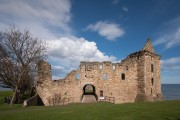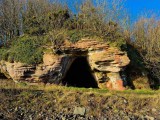With its colourful houses, orange tile roofs and historic harbours, the East Neuk of Fife feels like the perfect place to escape.
Long before it became a weekend photographer’s dream though, this stretch of coastline had some much more spiritual visitors.
The islands sitting in the Firth of Forth were popular with early Christian saints, ever since St Columba sent his followers to convert the local Picts in the 6th century. It was only a matter of time before those holy men made their way to the more comfortable shores of Fife.
The most obvious connection is St Monans, still named after a legendary saint who once lived on the Isle of May. Monan was said to have been one of the few fortunate survivors after Vikings attacked the island in the 9th century. He escaped to the mainland and lived the rest of his life alone in a small cave.
The impressive St Monans Church is slightly more modern than that, King David II ordering its construction in the 14th century. It’s one of the best surviving medieval churches in Scotland, but this was a strange place for the King to build a church and an even more peculiar saint to dedicate it to. There are two competing stories that might explain the monarch’s actions.
The more common theory is that the David was caught in an almighty storm that had blown out of nowhere along the Forth. His ship was wrecked and the King close to drowning in the choppy water. David prayed for his life as he swam for all he was worth, eventually washing up on the rocks right next to the shrine to St Monan.
Another theory is that David travelled here deliberately to seek the help of this little-known saint. The King had only recently been released from English captivity, having spent 11 years as a prisoner after the disastrous Battle of Neville’s Cross
During the fighting, David had been in the thick of the action, taking two arrowheads to the face. One had been removed but the other was lodged far too deeply. Throughout his long years in English custody, the King was forced to live with the agonising wound. It served as an almost constant reminder of his greatest failure in battle.
Released in 1357, David is said to have travelled to the shrine of St Monan, seeking spiritual help for his pain. While deep in prayer, the barbed arrowhead miraculously worked its way out of his head, falling through his nose and clattering to the ground.
Whatever the true story, King David clearly thought highly of St Monan and the 650-year-old church he built is still standing strong.
Further along the coast, St Fillan’s Cave is tucked away down a narrow wynd in Pittenweem. This popular saint must have been incredibly well travelled as legends and holy sites connected with him are found all over Scotland. The holy man supposedly chose to spend the majority of his time in Pittenweem living as a hermit.
The name Pittenweem means “place of the cave” and St Fillan chose a life of seclusion in this spacious hollow. When he wasn’t spreading the word of God to the surrounding people of Fife, Fillan tirelessly read and copied the Holy Scriptures.
Even on the sunniest of days, there’s very little light penetrating all the way into these depths, but Fillan had a trick very literally up his sleeve. His left arm miraculously glowed, allowing him to carry on studying and writing in the darkness.
After his death, the saint’s arm became an important relic, taken away from Pittenweem to safety at the Inchaffray Abbey. Before Robert the Bruce’s famous battle at Bannockburn in July 1314, the King of Scots called for help from on high. Robert realised he was going to need a guiding hand to secure victory and requested the arm of St Fillan be brought to bless his army.
The Abbot of Inchaffray wasn’t confident that the Scots would win the battle though. They were badly outnumbered and even with St Fillan’s help, the hope of victory looked slim. He refused to risk the holy arm falling into English hands and taken from Scotland forever.
Unknown to King Robert, he was brought nothing more than an empty box with no relic inside. The abbot tried to convince the King that it was far too risky to reveal something so valuable amongst the chaos of war. Just asking for St Fillan’s blessing while the arm was safely stashed inside would be enough to ensure victory.
Robert wasn’t somebody who could be told what to do though. Ignoring the abbot’s advice, he declared that this battle was too important to be left to chance. He was going to look upon and even touch the sacred bones with his own hands. We can be fairly sure that the Abbot of Inchaffray was making some very silent prayers as the King reached for the box.
Suddenly, a strange rattling noise came from beneath the lid. Curious as to what was happening, Robert slowly opened the lid to peer inside. To the abbot’s equal surprise and relief, St Fillan’s arm had miraculously appeared.
Admitting what he had done, the disobedient churchman begged for forgiveness but if anything, the King was delighted. It was surely a sign that God was on their side and after some vicious fighting, the Scots had won their greatest ever victory.
Pittenweem Priory would be built on top of St Fillan’s Cave, but the holy man’s hideout would eventually be forgotten about. It’s said to have been rediscovered after a horse working in the priory garden fell through the cave roof. A new opening was created at street level and the cave cleaned up to become a popular attraction in the village.
These early saints of the East Neuk left behind an impression that has lasted for over 1000 years. It’s clear that they knew a good spot when they saw one.
Storytelling by Scotland's Stories





